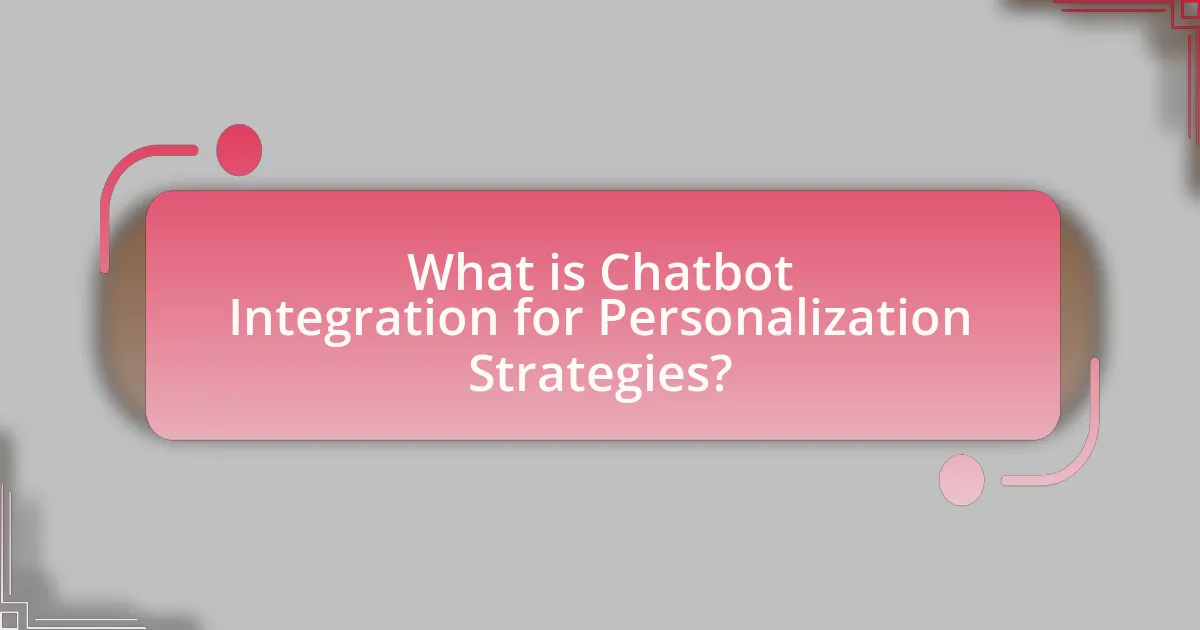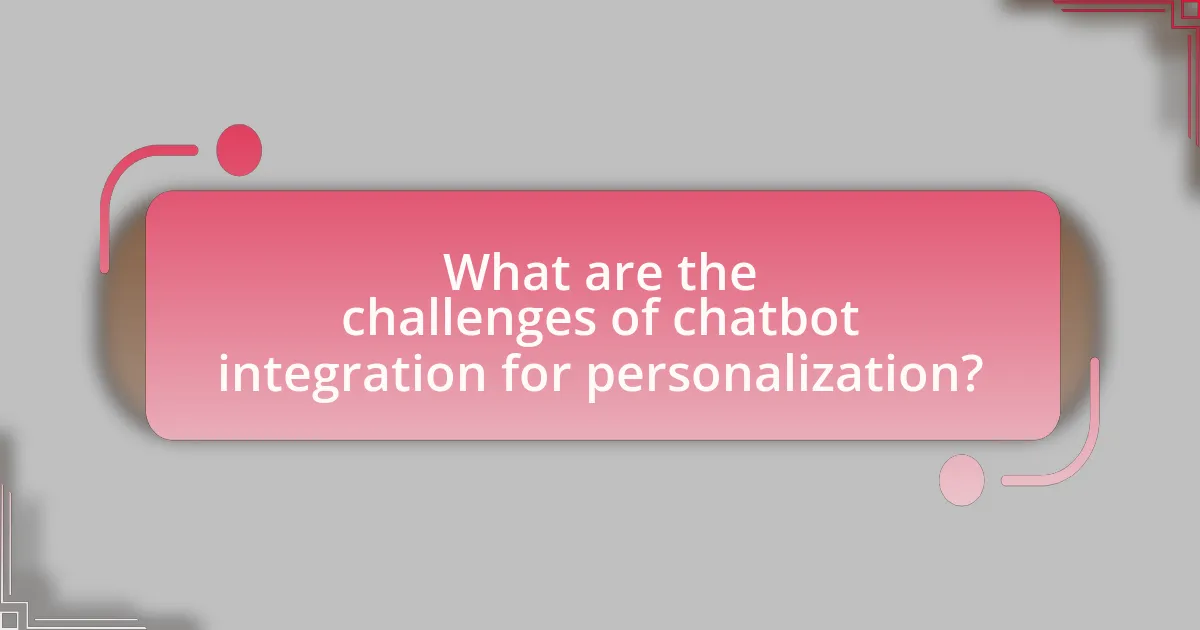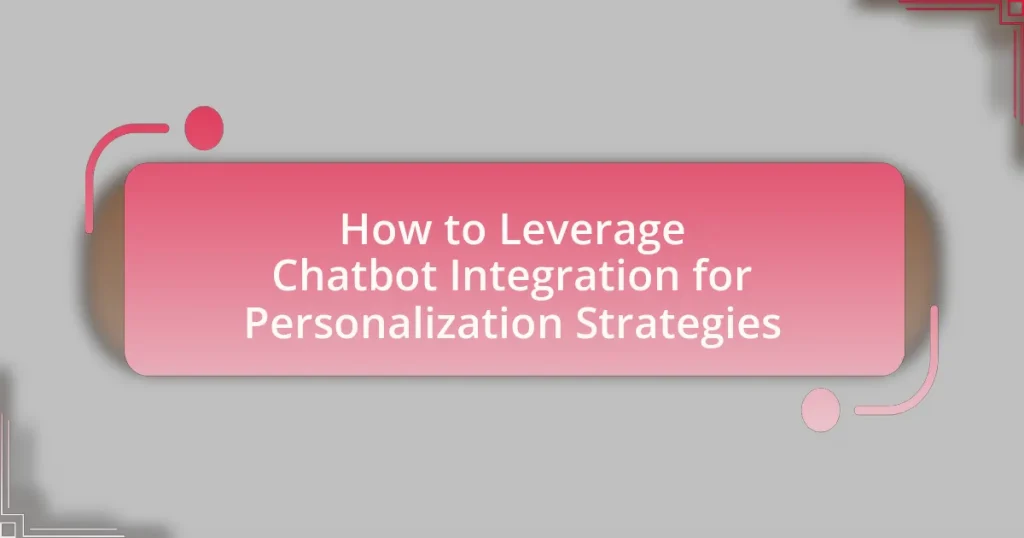Chatbot integration for personalization strategies involves incorporating chatbot technology into customer engagement processes to deliver tailored experiences based on individual user data and preferences. The article explores how chatbots enhance personalization through data analytics and machine learning, enabling businesses to provide customized recommendations and support. It discusses the technologies that facilitate this personalization, such as Artificial Intelligence and Natural Language Processing, and outlines the importance of personalization in improving customer satisfaction and loyalty. Additionally, the article addresses the challenges businesses face in integrating chatbots, strategies to overcome these obstacles, and best practices for optimizing chatbot personalization to enhance user engagement and retention.

What is Chatbot Integration for Personalization Strategies?
Chatbot integration for personalization strategies refers to the incorporation of chatbot technology into customer engagement processes to deliver tailored experiences based on individual user data and preferences. This integration allows businesses to analyze user interactions and behaviors, enabling chatbots to provide personalized recommendations, support, and content that resonate with each user. For instance, a study by Salesforce found that 70% of consumers expect personalized interactions, highlighting the importance of chatbots in meeting these expectations through data-driven insights and real-time responses.
How do chatbots enhance personalization in customer interactions?
Chatbots enhance personalization in customer interactions by utilizing data analytics and machine learning to tailor responses based on individual customer preferences and behaviors. They analyze past interactions, purchase history, and user data to provide customized recommendations and solutions, thereby improving customer satisfaction. For instance, a study by Salesforce found that 70% of consumers say a company’s understanding of their personal needs influences their loyalty. This demonstrates that chatbots, through their ability to deliver personalized experiences, significantly contribute to building stronger customer relationships.
What technologies enable chatbot personalization?
Artificial Intelligence (AI) and Natural Language Processing (NLP) technologies enable chatbot personalization. AI algorithms analyze user data, preferences, and behavior to tailor interactions, while NLP allows chatbots to understand and respond to user queries in a conversational manner. For instance, machine learning models can predict user needs based on past interactions, enhancing the personalization experience. Additionally, integration with customer relationship management (CRM) systems provides chatbots with access to user profiles, enabling them to deliver customized responses and recommendations. These technologies collectively enhance user engagement and satisfaction by creating a more relevant and personalized interaction.
How do chatbots gather user data for personalization?
Chatbots gather user data for personalization primarily through interactions and data collection mechanisms. They analyze user inputs, such as text queries and responses, to understand preferences and behaviors. Additionally, chatbots can utilize cookies and tracking technologies to gather information about user activity on websites or applications. This data is often supplemented by integrating with customer relationship management (CRM) systems, which provide historical data about user interactions and preferences. For instance, a study by Salesforce found that 70% of consumers expect personalized experiences from brands, highlighting the importance of data-driven personalization strategies in chatbot design.
Why is personalization important in today’s digital landscape?
Personalization is crucial in today’s digital landscape because it enhances user engagement and satisfaction. By tailoring content and experiences to individual preferences, businesses can significantly improve conversion rates; for instance, studies show that personalized emails have a 29% higher open rate compared to non-personalized ones. Furthermore, 80% of consumers are more likely to make a purchase when brands offer personalized experiences, demonstrating that personalization directly influences consumer behavior and loyalty.
What are the key benefits of personalized customer experiences?
Personalized customer experiences enhance customer satisfaction and loyalty. By tailoring interactions based on individual preferences and behaviors, businesses can significantly improve engagement rates. For instance, research by McKinsey indicates that personalization can lead to a 10-30% increase in revenue, as customers are more likely to respond positively to offers that resonate with their specific needs. Additionally, personalized experiences can reduce churn rates, as customers feel valued and understood, fostering long-term relationships with brands.
How does personalization impact customer loyalty and retention?
Personalization significantly enhances customer loyalty and retention by creating tailored experiences that meet individual preferences and needs. When businesses utilize personalization strategies, such as those enabled by chatbot integration, they can provide relevant recommendations and timely support, which fosters a stronger emotional connection with customers. Research indicates that 80% of consumers are more likely to make a purchase when brands offer personalized experiences, demonstrating that effective personalization can lead to increased customer satisfaction and repeat business. Furthermore, personalized interactions can reduce churn rates, as customers feel valued and understood, ultimately driving long-term loyalty.

How can businesses effectively leverage chatbot integration?
Businesses can effectively leverage chatbot integration by implementing personalized interactions that enhance customer engagement. By utilizing data analytics, businesses can tailor chatbot responses based on user behavior and preferences, leading to a more relevant and satisfying customer experience. For instance, a study by Salesforce found that 69% of consumers prefer chatbots for quick communication with brands, highlighting the importance of timely and personalized responses. Additionally, integrating chatbots with customer relationship management (CRM) systems allows businesses to access customer history and preferences, further improving the personalization of interactions. This strategic use of chatbot technology not only streamlines customer service but also fosters loyalty and increases conversion rates.
What steps should businesses take to implement chatbot integration?
Businesses should take the following steps to implement chatbot integration: first, define the objectives and use cases for the chatbot, ensuring alignment with customer needs and business goals. Next, select the appropriate technology platform that supports the desired functionalities, such as natural language processing and machine learning capabilities. After that, design the conversation flow and user experience, focusing on intuitive interactions that enhance user engagement.
Subsequently, businesses should develop and test the chatbot, iterating based on user feedback to refine its performance. Finally, integrate the chatbot with existing systems, such as CRM and customer support tools, to ensure seamless data flow and enhance personalization. According to a report by Gartner, 85% of customer interactions will be managed without a human by 2025, highlighting the importance of effective chatbot integration in modern business strategies.
How do you choose the right chatbot platform for your needs?
To choose the right chatbot platform for your needs, first assess your specific requirements, such as the intended use case, target audience, and integration capabilities. For instance, if your goal is customer support, select a platform that offers robust natural language processing and can integrate with your existing CRM systems. Additionally, consider the platform’s scalability, ease of use, and available analytics features to measure performance. Research shows that platforms like Dialogflow and Microsoft Bot Framework are favored for their flexibility and extensive documentation, making them suitable for various applications.
What are the best practices for designing a personalized chatbot experience?
The best practices for designing a personalized chatbot experience include understanding user intent, utilizing user data for customization, and ensuring seamless multi-channel integration. Understanding user intent allows the chatbot to respond accurately to inquiries, enhancing user satisfaction. Utilizing user data, such as previous interactions and preferences, enables the chatbot to tailor responses and recommendations, which has been shown to increase engagement by up to 50% (Salesforce, 2021). Seamless multi-channel integration ensures that users receive a consistent experience across platforms, which is critical as 70% of consumers expect connected experiences (McKinsey, 2020). These practices collectively contribute to a more effective and engaging chatbot experience.
How can businesses measure the success of chatbot personalization?
Businesses can measure the success of chatbot personalization through key performance indicators (KPIs) such as user engagement rates, customer satisfaction scores, and conversion rates. User engagement rates can be tracked by analyzing metrics like the number of interactions per session and the duration of conversations, which indicate how effectively the chatbot is resonating with users. Customer satisfaction scores can be gathered through post-interaction surveys, where users rate their experience, providing direct feedback on the personalization efforts. Conversion rates, which reflect the percentage of users completing desired actions (such as making a purchase or signing up for a newsletter), can also serve as a critical measure of how well the chatbot meets user needs through personalized interactions. According to a study by Salesforce, 69% of consumers prefer chatbots for quick communication with brands, highlighting the importance of effective personalization in driving user satisfaction and engagement.
What metrics should be tracked to evaluate chatbot performance?
To evaluate chatbot performance, key metrics include user engagement, response accuracy, conversation completion rate, and customer satisfaction scores. User engagement measures how often users interact with the chatbot, indicating its effectiveness in capturing attention. Response accuracy assesses the correctness of the chatbot’s replies, which is crucial for maintaining trust and reliability. The conversation completion rate tracks the percentage of interactions that lead to a successful resolution, reflecting the chatbot’s efficiency. Customer satisfaction scores, often gathered through post-interaction surveys, provide direct feedback on user experience and overall satisfaction with the chatbot’s performance. These metrics collectively offer a comprehensive view of how well a chatbot meets user needs and expectations.
How can feedback be used to improve chatbot personalization?
Feedback can be used to improve chatbot personalization by analyzing user interactions and preferences to tailor responses and recommendations. By collecting data on user satisfaction, common queries, and interaction patterns, developers can identify areas where the chatbot may fall short or excel. For instance, a study by the Journal of Artificial Intelligence Research found that chatbots that adapt based on user feedback can increase engagement by up to 30%. This data-driven approach allows for continuous refinement of the chatbot’s algorithms, enhancing its ability to provide relevant and personalized experiences for users.

What are the challenges of chatbot integration for personalization?
The challenges of chatbot integration for personalization include data privacy concerns, limited understanding of user intent, and the complexity of integrating with existing systems. Data privacy concerns arise as chatbots often require access to personal information to provide tailored experiences, which can lead to compliance issues with regulations like GDPR. Limited understanding of user intent can hinder a chatbot’s ability to deliver relevant responses, as natural language processing may not always accurately interpret user queries. Additionally, the complexity of integrating chatbots with existing customer relationship management systems and databases can create technical barriers, making it difficult to achieve seamless personalization. These challenges highlight the need for careful planning and robust technology solutions to effectively implement personalized chatbot experiences.
What common obstacles do businesses face when integrating chatbots?
Businesses commonly face several obstacles when integrating chatbots, including technical challenges, user acceptance, and data privacy concerns. Technical challenges arise from the complexity of integrating chatbots with existing systems and ensuring they function seamlessly across various platforms. User acceptance is critical, as customers may be hesitant to interact with chatbots due to concerns about their effectiveness or a preference for human interaction. Data privacy concerns are significant, as businesses must navigate regulations like GDPR while ensuring user data is handled securely. These obstacles can hinder the successful implementation and effectiveness of chatbot solutions in enhancing personalization strategies.
How can data privacy concerns affect chatbot personalization?
Data privacy concerns can significantly limit chatbot personalization by restricting the amount of user data that can be collected and utilized. When users are apprehensive about how their personal information is handled, they may opt out of sharing data, which is essential for tailoring chatbot interactions to individual preferences. According to a 2021 survey by the Pew Research Center, 79% of Americans expressed concern about how their data is used by companies, indicating a widespread reluctance to share personal information. This reluctance can lead to less effective personalization, as chatbots rely on data such as user behavior, preferences, and past interactions to provide customized responses. Consequently, organizations may need to prioritize transparency and data protection measures to build trust and encourage users to engage more openly with chatbots, ultimately enhancing personalization efforts.
What strategies can mitigate the risks associated with chatbot integration?
To mitigate the risks associated with chatbot integration, organizations should implement robust testing protocols, ensure data privacy compliance, and provide continuous monitoring and updates. Testing protocols, including user acceptance testing and stress testing, help identify potential issues before deployment, reducing the likelihood of failures. Compliance with data privacy regulations, such as GDPR, safeguards user information and builds trust. Continuous monitoring allows for real-time adjustments based on user interactions, ensuring the chatbot remains effective and secure. These strategies collectively enhance the reliability and safety of chatbot systems, as evidenced by studies showing that organizations with comprehensive testing and monitoring frameworks experience 30% fewer operational disruptions.
How can businesses overcome these challenges?
Businesses can overcome challenges in chatbot integration for personalization strategies by implementing a structured approach that includes thorough planning, continuous training, and data analysis. Effective planning involves defining clear objectives for chatbot functionality and user experience, ensuring alignment with customer needs. Continuous training of the chatbot using machine learning algorithms enhances its ability to understand and respond to user queries accurately, which is crucial for personalization. Data analysis plays a vital role in refining chatbot interactions; businesses should regularly assess user feedback and engagement metrics to identify areas for improvement. According to a study by Gartner, organizations that prioritize data-driven decision-making are 5 times more likely to make faster decisions than their competitors, highlighting the importance of data in overcoming integration challenges.
What role does continuous training play in chatbot effectiveness?
Continuous training is essential for enhancing chatbot effectiveness by ensuring that the system remains up-to-date with user interactions and evolving language patterns. This ongoing process allows chatbots to learn from new data, adapt to user preferences, and improve their responses over time. Research indicates that chatbots that undergo regular updates and training can achieve a 30% increase in user satisfaction and engagement, as they become more accurate in understanding and responding to queries. Thus, continuous training directly contributes to the overall performance and reliability of chatbots in delivering personalized user experiences.
How can businesses ensure a seamless user experience with chatbots?
Businesses can ensure a seamless user experience with chatbots by implementing natural language processing (NLP) capabilities and continuous learning algorithms. These technologies enable chatbots to understand user intent accurately and respond in a conversational manner, which enhances user engagement. For instance, a study by Salesforce found that 69% of consumers prefer chatbots for quick communication with brands, highlighting the importance of effective interaction. Additionally, integrating chatbots with customer relationship management (CRM) systems allows for personalized responses based on user data, further improving the experience. By regularly updating the chatbot’s knowledge base and utilizing user feedback, businesses can refine interactions and maintain relevance, ensuring a smooth and efficient user experience.
What are some practical tips for optimizing chatbot personalization strategies?
To optimize chatbot personalization strategies, implement user data analysis to tailor interactions based on individual preferences and behaviors. By leveraging data analytics, chatbots can identify user patterns, enabling them to provide relevant responses and recommendations. For instance, a study by Salesforce found that 70% of consumers expect personalized experiences, highlighting the importance of customization in enhancing user satisfaction. Additionally, integrating machine learning algorithms allows chatbots to continuously learn from user interactions, improving their ability to predict needs and preferences over time. This approach not only increases engagement but also fosters customer loyalty, as personalized experiences are more likely to resonate with users.
How can businesses utilize customer feedback for ongoing improvements?
Businesses can utilize customer feedback for ongoing improvements by systematically collecting, analyzing, and implementing insights derived from customer interactions. This process allows companies to identify areas for enhancement in products, services, and customer experiences. For instance, a study by the Harvard Business Review found that companies that actively seek and act on customer feedback can increase customer retention rates by up to 15%. By integrating feedback mechanisms, such as surveys or chatbot interactions, businesses can gather real-time data that informs decision-making and fosters continuous improvement.
What are the key features to include in a personalized chatbot?
Key features to include in a personalized chatbot are user profiling, contextual understanding, multi-channel support, and adaptive learning. User profiling allows the chatbot to gather and utilize information about individual users, such as preferences and past interactions, to tailor responses. Contextual understanding enables the chatbot to comprehend the nuances of conversations, ensuring relevant and coherent interactions. Multi-channel support ensures the chatbot can engage users across various platforms, enhancing accessibility. Adaptive learning allows the chatbot to improve its responses over time based on user interactions, leading to a more refined and personalized experience. These features collectively enhance user engagement and satisfaction, making the chatbot more effective in meeting user needs.










